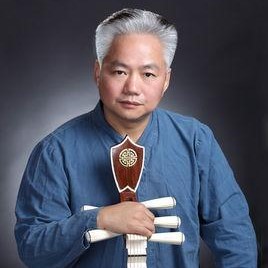Fang Jinlong
Organized by 琪琪 on 2022-02-09

Fang Jinlong (1963-), a native of Anqing, Anhui Province, a famous Chinese pipa player, a representative of modern five-string pipa, one of the "Four Heavenly Kings of Chinese Music", is now the "Jinlong Music Studio" of the Guangdong Provincial Art Institute Artistic Director.
Fang Jinlong has many unique developments and innovations in pipa playing skills. His performance is unique, with equal emphasis on passion and charm, and he is good at reflecting different characteristics and styles. He made the long-lost five-stringed lute and registered a patent based on historical data excavations, and is known as the master of the five-stringed lute.
He has published dozens of personal CD albums successively, such as "Pipa Xing", "Silent Night Thoughts", "Lin'an Regret", "House of Flying Daggers" and so on. Papers and monographs such as "Five-string Pipa Playing Method" and "Fang's Ruan Xian Fingering Method" have been published at home and abroad.
Similar artist
GYang Jin, young pipa player. Master of Arts in pipa Performance, Central Conservatory of Music, is now a pipa teacher at Wuhan Conservatory of Music.uzheng player Yu Qiuxuan - a different woman who dances with the guzheng
read >>
Cao Yang, pipa player of China Radio Chinese Orchestra, director of Pipa Professional Committee of China National Orchestra Society, master of Pipa of Central Conservatory of Music, One Hundred Outstanding Young People of China selected by the Ministry of Foreign Affairs, winner of the "Influential Person" Award of the annual China Hi-Fi Industry Festival.
read >>
LAN Weiwei, born in May 1980, studied at the Affiliated Middle School of Sichuan Conservatory of Music from 1992 to 1998. She has long been the chief of the strumming section of the Youth Chinese Orchestra of the Central Conservatory of Music.
read >>
Yu Yuanchun, female, teacher of the Central Conservatory of Music, the first doctor of pipa from the Central Conservatory of Music, director of the Chinese Ethnic Orchestral Society, pipa player of the National Orchestra of China, UNESCO special artist.
read >>
Involving musical instruments
Shakuhachi (pinyin: Chǐ bā), an ancient Chinese traditional musical instrument, was introduced to Japan during the Tang and Song Dynasties. Made of bamboo, with cinnabar mixed with lacquer on the inside to fill the (ground) incision, it is now five holes (the first four and the last one). Vast, but also can show the ethereal, quiet artistic conception.
Pipa (pinyin: pí pa), the first plucked instrument, is a traditional plucked instrument in East Asia, a plucked stringed musical instrument. Made of wood or bamboo, the speaker is half-pear-shaped and has four strings on the top. It was originally made of silk thread, but now it is mostly made of steel wire, steel rope and nylon.
Xiqin (pinyin: xī qín), also known as Erhu, originated in the Tang Dynasty. Xiqin can play all kinds of music flexibly, with cadence and rhythm, continuous and free, and can vividly express various emotions such as joy, anger, sadness, music, etc., especially the portamento played by it, which is almost the reproduction of language voice.
The Naxi Pipa (pinyin: nà xī pí pá) is a plucked stringed musical instrument of the Naxi people. Popular in Lijiang Naxi Autonomous County, Yunnan Province. The appearance is similar to the pipa in the Han area, but the volume is larger and the speaker is relatively flat and thin, retaining the ancient shape.
The five-stringed pipa (pinyin wǔ xián pí pá) is an ancient Chinese plucked stringed musical instrument. Referred to as "five strings". The five-stringed pipa has a long history and unique shape. It was popular in the vast Central Plains of my country during the Tang Dynasty, and spread to Japan, becoming a historical witness of Sino-Japanese cultural exchanges.
Involved portfolio
迦夜 - 60 views
长乐 - 37 views
拙 - 56 views
愛 - 40 views
没头脑 - 46 views
Involved news
Organized by 爱在西元 on 2024-12-17
With the gradual drop in temperature, the cold and dry winter is a special test for wooden instruments such as the pipa. In order to ensure that the pipa can still maintain its best condition and sound quality in the cold season, it is essential to take proper maintenance measures. Here are some important suggestions for winter maintenance of pipa.
read >>
Organized by 赵锦辛 on 2024-10-12
On the evening of October 7, the "Unparalleled Chinese Music · Jinse Dragon Walk" Fang Jinlong Qiuci First performance lecture was held in the high terrace residence of Saksak Street, Kuqa City, Xinjiang, bringing a unique musical and cultural feast to the general public and tourists.
read >>
Organized by 拙 on 2024-08-28
Australian pipa teacher Li Xinyang is promoting the charm of this traditional instrument on the local and international stage with his outstanding skills and love for Chinese music culture. Li Xinyang not only teaches pipa playing skills, but also dedicates himself to spreading the beauty of Chinese rhythm, so that more and more people can understand and fall in love with this ancient Oriental art form.
read >>
Organized by 梦昱 on 2024-08-19
On the evening of August 17, Chongqing Youth Plucked Orchestra held a unique pipa night concert in Jiangtan Park on Beibin Road. Several students from Chongqing, Henan, Sichuan and other places joined hands with the teachers on stage to perform a number of classic pipa songs and modern works.
read >>
Organized by CT. on 2024-08-07
Recently, the 5th Liaoyuan Pipa Culture and Art Week and the 5th "Liaoyuan Cup" Pipa Art Elite Exhibition opened in the Southern New Town Grand Theater of Liaoyuan City, Jilin Province.
read >>
 渝公网安备 50010702504639号
渝公网安备 50010702504639号